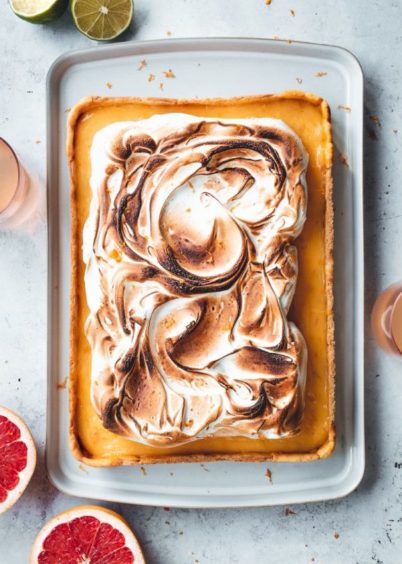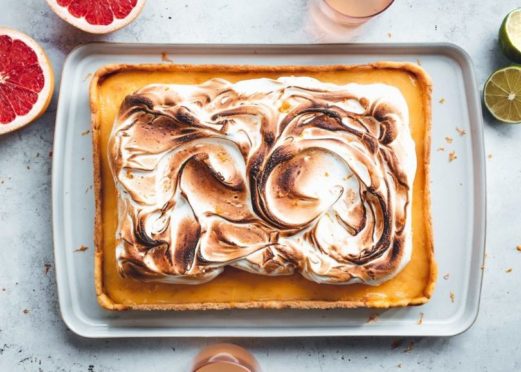Putting both your pastry and meringue-making skills to the test, this tasty grapefruit meringue pie is the dessert to trump all desserts
Our sweet treat recipe this week is as equally bold as it is delicious and is the perfect way to test both your pastry skills and your meringue-whipping abilities.
It’s not as difficult as you may thing, especially if you take each stage one at a time. Once you’ve mastered it though (and we know you will) you’ll be the talk of the town.
Combining the sweetness of grapefruit and the melt-in-mouth yummyness of the meringue is sure to be one of the best decisions you’ve ever made.
We’ll see you on the Great British Bake Off soon.
Recipe from One Tin Bakes by Edd Kimber is published by Kyle Books, priced £17.99. Photography by Edd Kimber.
Grapefruit meringue pie
(Serves 10-12)

Ingredients
1 fully baked 23 x 33cm tart case
For the custard filling:
- 350g caster sugar
- 50g cornflour
- Zest of 2 ruby grapefruits
- Zest of 3 limes
- 360ml ruby grapefruit juice (from 3-4 large grapefruits)
- 90ml lime juice (from about 4 limes)
- 4 large egg yolks
- 160ml double cream
- 30g unsalted butter
For the meringue topping:
- 4 large egg whites
- 300g caster sugar
- ¼ tsp cream of tartar
- 1 tsp vanilla bean paste
- ¼ tsp grapefruit (or other citrus) bitters
For the pastry case:
- 300g plain flour
- 50g icing sugar
- ¼ tsp fine sea salt
- 185g unsalted butter, diced and chilled
- 1 large egg
Method
- For the pastry, place the flour, icing sugar and salt in a food processor and pulse briefly together to combine.
- Add the butter and pulse until the mixture resembles breadcrumbs, then add the egg and pulse until the mixture starts to clump together.
- At this point, you can either use the dough as a press-in crust or chill it and roll it out. If rolling it, tip the mixture on to the work surface and bring it together as a dough with your hands. Form into a rectangle, wrap in clingfilm and refrigerate for at least an hour before using.
- If using as a press-in crust, tip the mixture directly into the baking tin and loosely spread evenly to cover the bottom of the tin. Press up the sides of the tin to create the tart sides, then firmly press the remaining pastry over the base. Dock with a fork and refrigerate for at least an hour before baking.
- If rolling, roll out between two sheets of parchment paper into a rectangle, roughly 30.5 x 40.5cm. Transfer to a baking tray and refrigerate for another 30 minutes to firm up. Lightly grease the tin and line the base with parchment paper.
- Preheat the oven to 180C/350F/Gas Mark 4.
- Peel the parchment paper from both sides of the pastry and carefully drape the pastry into the baking tin, gently pressing it into the corners and up the sides. Trim off the top edges then line with a piece of crumpled parchment paper and fill with baking beans or rice.
- Bake for 25 minutes, then remove the paper and beans/rice and bake for a further 10 minutes or until the base is set. Set aside.
- To make the custard filling, place the caster sugar and cornflour into a large saucepan and whisk to combine. Add the remaining ingredients, except the butter, and whisk to combine.
- Cook over a medium-high heat, whisking constantly, until the mixture comes to a simmer, then cook for a further two minutes until thick.
- Remove from the heat, stir through the butter until melted and smooth, then pour the custard into the baked tart case.
- Press a sheet of cling film on to the surface of the custard to prevent a skin from forming. Leave at room temperature for an hour, then transfer to the refrigerator for at least four hours.
- For the meringue topping, place the egg whites, sugar and cream of tartar into a large, heatproof bowl set over a pan of simmering water (ensuring the bottom of the bowl doesn’t touch the water underneath) and whisk until the sugar has dissolved.
- You can tell when this mixture is ready by rubbing a little between your fingers. If it feels smooth it is ready, if you feel grains of sugar, cook for longer.
- Remove the bowl from the heat and, using an electric mixer, whisk until the meringue is stiff and glossy. Add the vanilla and bitters and whisk briefly to combine.
- Scrape the meringue on to the tart and spread evenly over the filling.
- Using a blowtorch or under a preheated hot grill, burnish the meringue until toasted.
- Kept in the refrigerator, without the meringue, this tart will keep for a couple of days, but my preference is to serve it as close to making as possible to keep the pastry at its crispest.
More in this series…
Sweet Treats: This coffee and hazelnut Eton mess will keep your dessert in order
